Mostrar el registro sencillo del ítem
Guía metodologica para la elaboración de programas de optimización de sistemas de acueductos
| dc.contributor.advisor | Acero, Germán (dir) | spa |
| dc.contributor.author | Pimienta Vera, Johana Patricia | spa |
| dc.date.accessioned | 2014-12-10T14:06:25Z | spa |
| dc.date.accessioned | 2021-10-01T14:39:21Z | |
| dc.date.available | 2014-12-10T14:06:25Z | spa |
| dc.date.available | 2021-10-01T14:39:21Z | |
| dc.date.issued | 2013 | spa |
| dc.identifier.uri | http://catalogo.escuelaing.edu.co/cgi-bin/koha/opac-detail.pl?biblionumber=16650 | spa |
| dc.identifier.uri | https://repositorio.escuelaing.edu.co/handle/001/76 | |
| dc.description.abstract | El abastecimiento de agua potable a la comunidad colombiana es actualmente uno de los temas que ocupa especial interés en el gobierno nacional, el cual busca incentivar la creación de nuevos acueductos y la optimización de los ya existentes con el fin de minimizar los riesgos en la salud humana a causa de la falta del recurso o su inadecuado tratamiento; lo anterior enmarcado en el desarrollo sostenible y uso racional del agua. Para nadie es un secreto que la mayoría de las pequeñas comunidades en el país no cuentan con un buen servicio de agua potable, la infraestructura es inadecuada lo que ocasionando riesgo a la salud humana, pérdida de agua en el sistema y erosión hacia el suelo, haciendo que el sistema se vuelva más inestable. Adicional a esto los costos de transporte y tratamiento generalmente son muy altos y el desperdicio del recurso hace que menos usuarios reciban el suministro. Es por esto que en el presente documento se reseña inicialmente una estadística del estado de los acueductos en el país partiendo del análisis realizado por la UNICEF a los planes o esquemas de ordenamiento de los Municipios de Colombia y se plantea cinco programas de optimización que ayudaran a mejorar los sistemas de acueductos, hacerlos más eficientes y usando racionalmente el agua para garantizar una mayor cobertura y calidad a la población. La optimización de los sistemas de acueducto busca en primer lugar evitar problemas de falta de servicio con sus consecuencias sanitarias y en segundo lugar, pérdidas económicas debido a lo costoso que puede resultar de la falta de mantenimiento, la adecuada operación de cada uno de los componentes del sistema y el uso inadecuado del recurso hídrico. Se plantea un primer programa el cual consiste en establecer los pasos para definir la diferencia entre el agua producida y el agua facturada y las posibles causas; por ejemplo, problemas en el sistema de medición, por las conexiones clandestinas y/o por las fugas de agua a causa del deterioro o deficiencias en los componentes del sistema de acueducto. Con lo cual se pueden encaminar acciones para reducir el índice de agua no contabilizada y con ello optimizar los recursos económicos del prestador y sus usuarios legales, y disminuir la demanda del recurso hídrico generando un bienestar ambiental para la región. El segundo programa consiste en la adecuada operación y mantenimiento del sistema, ya que en la mayoría de los acueductos por el desconocimiento en su operación y la falta de mantenimiento hacen que estos sean obsoletos, no cumplan adecuadamente su función, propicien la contaminación de agua y que se deban invertir grandes sumas de dinero para su restablecimiento, dinero con que no cuenta las empresas encargadas de la prestación del servicio o sus usuarios. La correcta operación y mantenimiento hace que se garantice un correcto transporte y tratamiento del agua, minimizando los costos. El establecer los riesgos a los cuales son susceptibles todas las estructuras hidráulicas que componen el sistema de acueducto propenderá a establecer un plan de acción con el fin de minimizar la vulnerabilidad del sistema o a plan de contingencia en caso de que alguna eventualidad que ponga en riesgo la continuidad, cobertura y/o calidad en el suministro de agua potable a la población. El programa de almacenamiento domiciliario busca generar conciencia directamente en los usuarios, sobre el uso racional del agua y la importancia de tener reservas para evitarse el desabastecimiento y con ello facilitar las operaciones de mantenimiento y limpieza al sistema. Y por último y no menos importante el programa de uso eficiente y ahorro del agua con el cual se integran todos los programas anteriores en busca de garantizar una armonía entre la comunidad y su entorno natural, la preservación del recuso para que más personas tengan acceso al preciado líquido y las generaciones futuras puedan gozar de un ambiente sano. | spa |
| dc.description.abstract | The supply of drinking water to the Colombian community is currently one of the topics of special interest in the national government, which seeks to encourage the creation of new aqueducts and the optimization of existing ones in order to minimize health risks human because of the lack of the resource or its inadequate treatment; this is framed in the sustainable development and rational use of water. It is no secret to anybody that most of the small communities in the country do not have a good potable water service, the infrastructure is inadequate, which causes risk to human health, loss of water in the system and erosion towards the ground, causing the system to become more unstable. In addition to this, transport and treatment costs are generally very high and the waste of the resource means that fewer users receive the supply. That is why in this document we initially review a statistic of the state of the aqueducts in the country based on the analysis made by UNICEF to the planning plans or schemes of the Municipalities of Colombia and proposes five optimization programs that will help improve aqueduct systems, make them more efficient and rationally use water to ensure greater coverage and quality to the population. The optimization of the aqueduct systems seeks in the first place to avoid problems of lack of service with its sanitary consequences and secondly, economic losses due to the cost that can result from the lack of maintenance, the adequate operation of each of the components of the system and the inadequate use of water resources. A first program is proposed, which consists of establishing the steps to define the difference between the water produced and the water billed and the possible causes; for example, problems in the measurement system, clandestine connections and / or water leaks due to deterioration or deficiencies in the components of the aqueduct system. With this, actions can be taken to reduce the unaccounted-for water index and thereby optimize the economic resources of the provider and its legal users, and reduce the demand for water resources, generating environmental well-being for the region. The second program consists of the proper operation and maintenance of the system, since in most of the aqueducts due to the lack of knowledge in their operation and the lack of maintenance they are obsolete, do not adequately fulfill their function, promote water pollution and that large sums of money must be invested for its restoration, money that does not count the companies in charge of providing the service or its users. The correct operation and maintenance ensures that proper transportation and water treatment is guaranteed, minimizing costs. Establishing the risks to which all the hydraulic structures that make up the aqueduct system are susceptible will tend to establish an action plan in order to minimize the vulnerability of the system or contingency plan in case any eventuality that puts the continuity, coverage and / or quality in the supply of drinking water to the population. The home storage program seeks to generate awareness directly in the users, on the rational use of water and the importance of having reserves to avoid shortages and thus facilitate maintenance and cleaning operations to the system. And last but not least, the program of efficient use and saving of the water with which all the previous programs are integrated in search of guaranteeing a harmony between the community and its natural environment, the preservation of the recuse so that more people have access to the precious liquid and future generations can enjoy a healthy environment. | eng |
| dc.format.mimetype | application/pdf | spa |
| dc.language.iso | spa | spa |
| dc.publisher | Escuela Colombiana de Ingeniería Julio Garavito | spa |
| dc.rights | Derechos Reservados - Escuela Colombiana de Ingeniería Julio Garavito | spa |
| dc.rights.uri | https://creativecommons.org/licenses/by-nc/4.0/ | spa |
| dc.subject | Acueductos | spa |
| dc.subject | Diseño y Construcción de acueductos | spa |
| dc.title | Guía metodologica para la elaboración de programas de optimización de sistemas de acueductos | spa |
| dc.type | Trabajo de grado - Especialización | spa |
| dc.type.version | info:eu-repo/semantics/publishedVersion | spa |
| oaire.accessrights | http://purl.org/coar/access_right/c_14cb | spa |
| oaire.version | http://purl.org/coar/version/c_970fb48d4fbd8a85 | spa |
| dc.description.degreelevel | Especialización | spa |
| dc.description.degreename | Especialista en Recursos Hidráulicos y Medio Ambiente | spa |
| dc.publisher.program | Especialización en Recursos Hidráulicos y Medio Ambiente | spa |
| dc.rights.accessrights | info:eu-repo/semantics/closedAccess | spa |
| dc.rights.creativecommons | Atribución-NoComercial 4.0 Internacional (CC BY-NC 4.0) | spa |
| dc.type.coar | http://purl.org/coar/resource_type/c_7a1f | spa |
| dc.type.content | Text | spa |
| dc.type.driver | info:eu-repo/semantics/bachelorThesis | spa |
| dc.type.redcol | http://purl.org/redcol/resource_type/TP | spa |
| dc.subject.keywords | Aqueducts | spa |
| dc.subject.keywords | Design and construction of aqueducts | spa |
Ficheros en el ítem
Este ítem aparece en la(s) siguiente(s) colección(ones)
-
CD - Trabajos de Grado Especialización en Recursos Hidráulicos [108]
Trabajos de Grado de la Especialización en Recursos Hidráulicos y Medio Ambiente de la Escuela Colombiana de Ingeniería Julio Garavito












